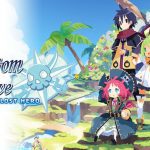Eiyuden Chronicle: Hundred Heroes was a successful Kickstarter (so far), with that game coming out next year. It’s interesting, being a Suikoden-inspired RPG (and I think some of the original Suikoden devs are part of the team) with, as the title says, at least a hundred characters you can use to build your party. Looks cool.
Rising is a prequel to that game, which, I presume, features a few of the characters and a very small look at the world of the final game. This one is an action RPG instead.
So… yeah, let’s review this!
Developer: Rabbit & Bear Studios Inc.
Publisher: 505 Games
Release date: May 10th, 2022
Platforms: Switch, PC, PS4, Xbone, PS5, Xbox X/S (Switch version reviewed)
Genre: Action RPG
Review
You play as CJ, a young scavenger who is out on a quest to find a big treasure, like her father before her. She hears about the town of New Nevaeh which has been advertising a dungeon possibly filled with treasure, open for adventurers to explore and find artifacts, which they explain in detail how you get artifacts appraised and share revenue with the town. Specifically, the acting Mayor of the town makes you do a few tasks around town to show you’re serious about it before even being allowed into the dungeon. You find out a bunch of stuff about this dungeon as you go, from when it appeared, who discovered it, why there’s an acting mayor and the whole system of artifact appraisal, and the history of the area. You do end up teaming up with a few people as well. It’s not a bad story, I liked the main characters. It actually builds up mystery pretty effectively, and other than a few moments where
You know, in the story of the game, there’s a lot of time spent talking about how there are rules as far as revenue split when you find shit in the dungeon and bring it back to the town. So I made the assumption pretty quickly that this was gonna be central to the gameplay so that a lot of the gameplay loop would be exploring the dungeon, finding cool treasure, and bringing it back to town to get it appraised and get your share of the revenue. Yeah, this doesn’t happen. I find it so weird that they intricately explain this system of having to pay 30% of an item’s value when you take it out of the dungeon and how you need to get it appraised and stuff… just for none of it to matter, at all.
I never talk about music in games, but this is a rare exception where I did actually pay some attention to it… It wasn’t amazing. Not bad, but… there’s something about how unexciting it was in moments that are meant to be exciting. Heck, the final boss cutscene just plays the same quiet music from the dungeon, there’s something off about how music is decided in-game. And since we’re still on presentation, I’d say I kinda wish the character sprites were a bit more expressive (since their portraits are all very nice), but otherwise, the graphics are fine, some of the enemies look pretty cool and there’s nothing that gets in the way of the gameplay.
So gameplay! Basically, it’s a “talk to NPCs and do what they tell you” kind of game. That’s pretty much the game flow. Find an NPC in town with an exclamation point above their head, spend a bunch of time in a dialogue cutscene, then go where they told you to. This can be just to another NPC to get more dialogue, or in a dungeon to find materials, or just to progress through said dungeon normally to fight a boss. Doing your task means you can get to the next one. There’s also side-quests in town, which you do pretty much need to do because that’s how you get stronger. Doing side-quests gives you rewards, but each of the stores may also get new inventory. More on that later.
So in dungeons, how you play is a bit unique. You control one character at a time, out of 3 total that you end up getting in your party. That character can move, jump, attack and use a special action. Each character has different jumping, attacks and movement capabilities. Namely, you’ll spend most of the game playing as CJ because Garoo and Isha kinda suck (minus Isha’s long-range attack capability, and link attacks). Fighting is fairly standard side-scrolling stuff. Each character has an attack that hits at some range in from of them… that’s about it. You can dodge by jumping, moving, or, if you’re CJ, dashing. But there’s more! Namely, switching characters. This is pretty simple. Each character has an attack button, so you just switch characters by pressing their attack button. This won’t instantly launch the attack, just switch characters. But if you switch characters during an attack, you’ll launch a Link Attack. You can launch several of those in a row if you time the attack correctly, which are fairly strong attacks.
You get stronger partly by killing stuff, of course, but more importantly, it’s all about building up the town. You and one builder are doing everything in New Nevaeh, so as you do side-quests, new stores get set up, and new stuff becomes available at those stores. The blacksmith, weapon shop and armor shop are the most important strength-wise (and maybe the tavern). The Blacksmith allows to strengthen the weapons and armor, this is just straight-up stat upgrades. The weapon shop provides upgrades for weapons, which do give extra stats, but also give better attack options such as more hits in your ground or air combos, or charge attacks. The armor shop also gives some defense power increase, but armor also increases your movement options, such as giving CJ more jumps or Isha more hover time (note: hovering is useless). More importantly for Isha is the Runes. Runes give elemental advantages to your attacks (or can be used to earn elemental resist as well), but for Isha, this also affects the spell she’ll use for her basic attack. You’ll probably find one you prefer. There’s several other shops as well, such as ones that improve the quality of material drops, or allow you to actually buy things. The most notable is the tavern in this case, as it lets you recover HP without wasting potions, but each meal also increases your stats a little bit. There’s also another way to heal your HP, that being going back to your house and resting. You literally never need to do that. Just use the tavern and get stats.
And that’s about it here. You go in the dungeon, kill some things, come back for dialogue, do way too much side content, and so on… It’s fine, not a bad loop, even if most of the sidequests are pretty lame that hardly count as gameplay.
Overall
I thought this was okay. The combat was fine once I put my TV to game mode (I was having HEAVY input delay without it, not something I noticed with other games) but it’s very simple, the boss battles were pretty decent, and there’s a bunch to do… though the sidequests started really annoying me by the end, as most of them are just “go talk to this person and come back”, which isn’t gameplay (and you can’t convince me that it is). At least gathering materials for sidequests is something, and the main exploration is fine.
I’d put a mild recommendation on this. If you’re hyped for Eiyuden Chronicle: Hundred Heroes, this is at least a small look into the world.








Leave a reply